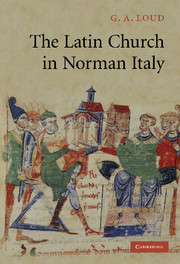Book contents
- Frontmatter
- Contents
- Preface
- List of maps
- List of abbreviations
- Map I Southern Italy: archbishoprics and principal bishoprics
- Map II Southern Italy: abbeys
- Map III The dioceses of Sicily in the late twelfth century
- Map IV The dioceses of the Terra di Bari
- Map V The dioceses of the Terra di Lavoro
- Introduction
- 1 The Church in southern Italy before the Normans
- 2 The Church and the Norman conquest
- 3 The papacy and the rulers of southern Italy
- 4 The papacy and the Church in southern Italy
- 5 The kings of Sicily and the Church
- 6 The Church and military obligation
- 7 The secular Church
- 8 Monasticism
- 9 Latins, Greeks and non-Christians
- Conclusion
- Appendices
- Bibliography
- Index
4 - The papacy and the Church in southern Italy
Published online by Cambridge University Press: 04 May 2010
- Frontmatter
- Contents
- Preface
- List of maps
- List of abbreviations
- Map I Southern Italy: archbishoprics and principal bishoprics
- Map II Southern Italy: abbeys
- Map III The dioceses of Sicily in the late twelfth century
- Map IV The dioceses of the Terra di Bari
- Map V The dioceses of the Terra di Lavoro
- Introduction
- 1 The Church in southern Italy before the Normans
- 2 The Church and the Norman conquest
- 3 The papacy and the rulers of southern Italy
- 4 The papacy and the Church in southern Italy
- 5 The kings of Sicily and the Church
- 6 The Church and military obligation
- 7 The secular Church
- 8 Monasticism
- 9 Latins, Greeks and non-Christians
- Conclusion
- Appendices
- Bibliography
- Index
Summary
When William of Apulia described the synod of Melfi of 1059, where Robert Guiscard was invested as duke, it was notable that he mentioned the ducal investiture almost as an afterthought. The pope, he said, ‘had come to this region to deal with ecclesiastical affairs’, and his discussion of the council concentrated on Nicholas II's efforts to encourage clerical celibacy. This account reminds us that papal concerns with southern Italy were not just with securing a political alliance with its rulers. The popes also sought to promote the reform and well-being of the south Italian Church, and one might well consider that this aspect was ultimately the more important of the two in their eyes. And, as William's description of the council at Melfi implied, there was in the mid-eleventh century a great deal within the Church in southern Italy that was in need of reform. He was concerned, or his account might suggest that Pope Nicholas was, primarily with the chastity of the clergy: ‘for the priests, levites and all the clergy of this area were openly joining themselves in marriage’, a state of affairs that the pope was determined to remedy. But while the papacy in the era of the Gregorian Reform was committed to the extirpation of clerical marriage, ‘so that the acceptable service of a white and spotless household may be offered to the bride of Christ who knows neither spot nor wrinkle’, there were other problems of the Church in southern Italy that were equally in need of attention.
- Type
- Chapter
- Information
- The Latin Church in Norman Italy , pp. 181 - 254Publisher: Cambridge University PressPrint publication year: 2007

